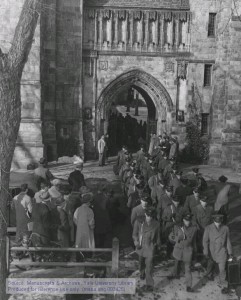
Richard (Dick) Shank stepped onto Yale’s campus in July of 1942 as a freshman, a member of the class of 1945. After his first year at Yale College, he attended the Yale School of Engineering where he elected to study electrical engineering. As an undergraduate, he was a member of Sigma Psi, a scientific society, and Tau Beta Pi, an engineering society. He was later made an honorary member of the Aurelian Honor Society in the 1950s.
In the early 1940s, Yale was greatly affected by the war, and certain changes to the institution were implemented. Summer terms were added, but students still completed their degrees in eight terms (thirty-two months). Like many of his classmates, Shank participated in the Naval ROTC program. He spent two and a half years in the Pacific. After his term, Shank returned to Yale and graduated in 1948 from the Yale School of Engineering with a B.E. in electrical engineering. He then continued on at Yale, receiving a master’s degree in electrical engineering and eventually becoming an assistant professor.
As an assistant professor, Shank taught an alternating current circuits course in addition to several engineering laboratories. He did administrative work with the registrar’s office and was the first dean of Branford College. He also oversaw many changes in the academic and social dynamics of Yale College.
The late 1940s saw the development of the transistor – a device used in circuits to amplify and switch electronic signals. Considered one of the most important inventions of the twentieth century, transistors greatly contributed to the development of electronics, specifically the use of the microchip. As electrical engineering boomed after transistors were invented, Shank saw academia in electrical engineering change as well. Yale’s engineering curriculum was reviewed every year, and Shank contributed to the review of the courses and topics to be taught. When Shank first began work in the registrar’s office, punched cards were used to record and store student data. He saw the transition from punched cards to computers at Yale, as the registrar’s office started to use computers to keep track of students’ transcripts and records.

When Shank first came to Yale in 1942, there were four academic deans of Yale: Dean of Freshmen, Dean of Yale College, Dean of the Sheffield Scientific School, and Dean of the School of Engineering. In 1932, the School of Engineering split from the Sheffield Scientific School and in 1945, the Sheffield Scientific School merged with Yale College. Although ten residential colleges were built in the 1930s and two more in 1961, the colleges did not have their own deans until 1963. In 1963, the office of the dean was discontinued and residential college deans were instituted. That year, Shank became the first dean of Branford College.
Having seen the development of engineering at Yale over the years, Shank is quite pleased with modern engineering at Yale. He believes that Yale has always made an active effort to keep up with new developments in the field and to incorporate them into the curriculum.
In particular, the Yale School of Engineering recently split into separate departments in order to further develop each department. The current Yale School of Engineering and Applied Science is composed of Biomedical Engineering, Enviornmental Engineering, Chemical Engineering, Electrical Engineering, Mechanical Engineering, and Applied Physics. Shank believes that the separation into these entities and Yale’s usage of the Accreditation Board for Engineering and Technology (ABET) have greatly improved engineering at Yale. He says he has much hope for the future of engineering at Yale, especially as President Richard Levin has been very dedicated to supporting the field. Shank is confident that further developments in engineering are on Yale’s horizon.
Shank retired as registrar of Yale College in 1985; however, he remains actively involved with the university. He is the treasurer of the Yale Class of 1945W and successor trustee and treasurer of the Aurelian Honor Society. However, Shank’s greatest love at Yale was for his teaching, and he is still in touch with many of his students. Along the way, he married the sister of a classmate. He and Carol are proud of their three children, who have each married and had four children.
